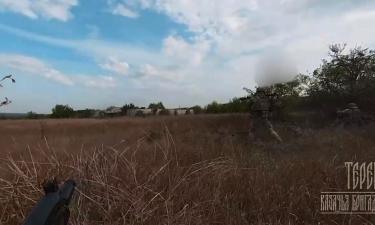Maker of AK-47 celebrates 205 years of triumph
The Izhevsk Arms Factory (Izhmash) was founded 205 years ago in the heart of the Udmurtia Republic. The factory became the main supplier of weapons to the Russian army. The production of arms was founded on the basis of the factory that was producing metal spare parts. The first war, in which the products of Izhmash factory took part, was the Patriotic War of 1812. The last war was the Great Patriotic War of 1941-1945.
The idea to build a weapons factory belonged to Emperor Paul. The idea occurred to him seven years before the production was founded in Izhevsk. The emperor entrusted all matters concerning the construction of the weapons factory to mining engineer Andrei Deryabin.
It did not take Deryabin long to find the location for the new factory. Having found the Izhevsk ironworks, (the name of the town originates from the Izh River), he pointed out such pluses as good water reserves for machines, forests for construction and the convenience of obtaining materials for weapons that were already developed at the metal-making factory. The engineer also noticed such peculiarities as open space for people to settle in the area.
The emperor praised the initiative, and gave approval for the construction of the plant, which began in 1807. The construction gave a powerful impetus to the economic development of the region. Thousands of peasants from all surrounding villages were attracted to the production. They were to provide workers with carts, horses and harness. Thus, thanks to Andrey Deryabin and his weapons factory, the city on the Izh River began to develop very fast.
The Izhevsk arms factory began to produce firearms and cold steel. Russia already had two such weapons factories at the moment when the new one was opened: in Tula and Sestroretsk. However, the Izhevsk factory had a variety of production facilities. The production of weapons was carried out in 14 stone buildings on one factory area. At the Tula factory, for example, there was only machine work conducted in state-owned factories. The workers were doing all other works at home.
The construction of more than a dozen productions, as well as the main building with a factory tower was conducted from 1811 to 1816. The works were not interrupted even during the Patriotic War in 1812, during which the plant had produced 2,000 rifles. Interestingly, the main building of the Izhevsk factory at that time was considered one of the highest industrial buildings in the world. This is where the majority of workers were concentrated.
The workshop structure of the plant developed during the first years of its operation. In 1814, the plant produced 10,000 rifles and about 2,500 broadswords. However, the factory had reached its full production capacity only by 1830. The plant began to produce 25,000 silicon guns and 5000 broadswords a year. The Izhevsk arms factory became the leading enterprise in the field and was able to reduce the cost of weapons 1.5 times compared to that in Tula.
The factory founded by Andrei Deryabin made a priceless contribution to the national arms production, having unified rifle parts.
The Izhevsk arms factory had to constantly improve its products in the pursuit after the global arms industry. In 1845, the factory began to produce enhanced seven-way smoothbore guns with the percussion lock.
In 1874, the Izhevsk Arms Factory started the production of Berdman's four-way gun. From 1870 to 1880, the number of Berdman rifles produced annually reached 300,000 items. The new generation of Izhevsk rifles were soon tried during the Russian-Turkish War.
During the second half of the XIX century, the factory was substantially re-equipped. Apart from 100 new machines ordered abroad, the plant received the machines, manufactured in the Russian Empire, including at the factory of Ludwig Nobel in St. Petersburg. As a result, the Izhevsk Arms Factory received more than a thousand new machines, and took the lead in the industry again. However, former competitors began to buy rifle parts from the Izhevsk factory having given it the reins of power in the industry.
The three-way Mosin rifle became another outstanding development of the Izhevsk factory. The production of the rifle began in 1891. This rifle, which made the Izhevsk factory famous, was produced in all varieties: for ground troops, for Dragoons, Cossacks and for training. Mosin rifles were manufactured till 1945. There were 56.793,640 Mosin rifles produced at the factory in total.
In addition to combat weapons, the Izhevsk factory was producing hunting rifles too. For example, Izhevsk shotguns received gold medals in 1900 at the Paris World Exhibition.
The powerful production capacity of the factory can be seen in the following facts. During the First World War, the conveyors of the factory produced 1.5 million rifles, and 11.3 million rifles and carbines during World War II, which exceeded the quantity of weapons produced by all German factories (10.3 million). During the Great Patriotic War, the Izhevsk factory was producing up to 18 types of weapons, including anti-tank Dyagterev and Simonov guns, aircraft machine guns, Berezin cannons, Shpitalny and Nudelman-Suranov aircraft guns.
However, the most unique and internationally known product of the Izhevsk arms factory was released after World War II. In 1948, the factory began to produce Kalashnikov assault rifles. The rifle later became the hallmark of Izhmash. The Kalashnikov rifle was passed into service in the Soviet Army and Navy in 1949. The famous AK-47 serves in the armies of 106 countries of the world.
Nowadays, the factory continues to produce sporting arms. The Izhevsk production has changed many times in the course of time. In 1953, the production of the TT pistol was stopped - the mass production of the Makarov pistol was launched. The production of missiles and various electronic control systems was launched during the same period of time. During the 1960s, the factory was awarded with the Order of Lenin and the Red Banner.
Maria Snytkova.
Subscribe to Pravda.Ru Telegram channel, Facebook, RSS!





